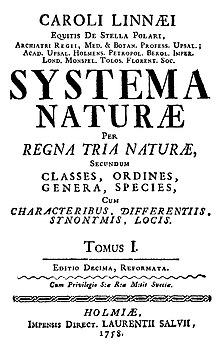
Back Systema Naturae Afrikaans نظام الطبيعة (كتاب) Arabic Systema naturæ AST Systema Naturae Azerbaijani Сістэма прыроды Byelorussian সিস্টেমা ন্যাচারাই Bengali/Bangla Systema Naturae Catalan Systema naturae Czech Systema Naturae Danish Systema Naturae German
 Title page of the 1758 edition of Linnaeus's Systema Naturæ[1] | |
| Author | Carl Linnaeus (Carl von Linné) |
|---|---|
| Country | Sweden |
| Subject | Taxonomy |
| Genre | Biological classification |
Publication date | 1735 |
| LC Class | QH43 .S21 |
Systema Naturae (originally in Latin written Systema Naturæ with the ligature æ) is one of the major works of the Swedish botanist, zoologist and physician Carl Linnaeus (1707–1778) and introduced the Linnaean taxonomy. Although the system, now known as binomial nomenclature, was partially developed by the Bauhin brothers, Gaspard and Johann,[2] Linnaeus was first to use it consistently throughout his book. The first edition was published in 1735. The full title of the 10th edition (1758), which was the most important one, was Systema naturæ per regna tria naturæ, secundum classes, ordines, genera, species, cum characteribus, differentiis, synonymis, locis, which appeared in English in 1806 with the title: "A General System of Nature, Through the Three Grand Kingdoms of Animals, Vegetables, and Minerals, Systematically Divided Into their Several Classes, Orders, Genera, Species, and Varieties, with their Habitations, Manners, Economy, Structure and Pecularities".[3]
The tenth edition of this book (1758) is considered the starting point of zoological nomenclature.[4] In 1766–1768 Linnaeus published the much enhanced 12th edition, the last under his authorship. Another again enhanced work in the same style and titled "Systema Naturae" was published by Johann Friedrich Gmelin between 1788 and 1793. Since at least the early 20th century, zoologists have commonly recognized this as the last edition belonging to this series.[5][6][7]
- ^ Linnaeus, Carl (1758). Systema naturae per regna tria naturae :secundum classes, ordines, genera, species, cum characteribus, differentiis, synonymis, locis (in Latin) (10th ed.). Stockholm: Laurentius Salvius.
- ^ Windelspecht, Michael (2002). Groundbreaking Scientific Experiments, Inventions, and Discoveries of the 17th century. Greenwood Publishing Group. ISBN 978-0-313-31501-5. p. 28.
- ^ Linné, Carl von (1806). A General System of Nature,: Through the Three Grand Kingdoms of Animals, Vegetables, and Minerals, Systematically Divided Into Their Several Classes, Orders, Genera, Species, and Varieties ... Lackington, Allen, and Company.
- ^ Gordh, Gordon; Beardsley, John W. (1999). "Taxonomy and biological control". In Bellows, T. S.; Fisher, T. W. (eds.). Handbook of Biological Control: Principles and Applications of Biological Control. Academic Press. pp. 45–55. ISBN 978-0-12-257305-7.
- ^ "Sherborn, C. D. 1902". Index Animalium.
- ^ "Neave, S. A. 1939–1940, updated". Nomenclator Zoologicus.
- ^ Opinions and Declarations rendered by the International Commission on Zoological Nomenclature 8: 167–178, also p. 318 in ICZN 1987. Archived 2010-06-25 at the Wayback Machine Official lists and indexes of names and works in zoology. – pp. 1–366. London. (The International Commission of Zoological Nomenclature).
© MMXXIII Rich X Search. We shall prevail. All rights reserved. Rich X Search